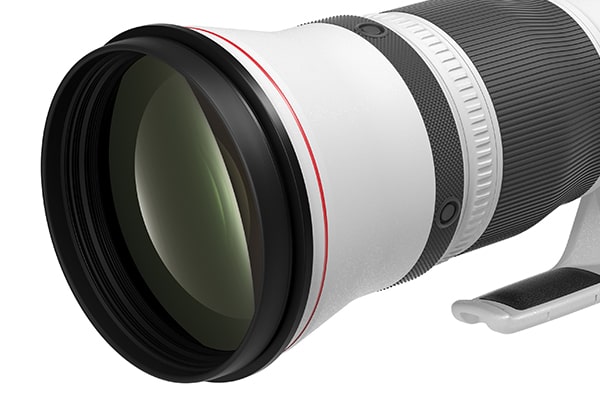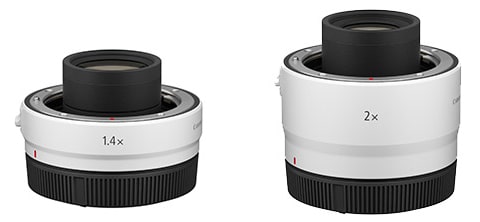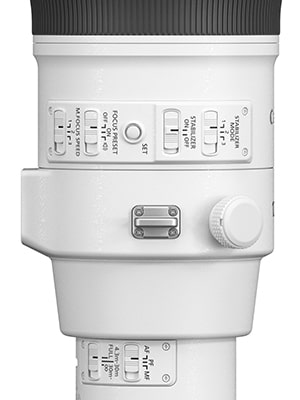Explore null | Canon Latin America

RF 1200mm f/8L IS USM
- RF 1200mm f/8L IS USM
- Lens Cap E-185C
- Lens Dust Cap RF
- Drop-in Screw Filter Holder 52 (WIII) with 52mm Protect Filter
- Lens Hood ET-160 (WIII)
- Lens Soft Case LS1200
- Lens Wide Strap B
-
OVERVIEW
-
SPECIFICATIONS
-
ACCESSORIES
-
RESOURCES
-
SUPPORT
-
MISCELLANEOUS
The RF 1200mm f/8L IS USM super-telephoto, fixed focal length lens is the longest telephoto lens among Canon's EOS R System lineup**, making it a terrific choice for any long-distance application such as outdoor sports, wildlife, news photojournalism, and more where you want to create super-tele impact. Two large-diameter Fluorite elements, one Super UD (Ultra-low Dispersion) and one UD-glass element, and Air Sphere Coating combine for superb optical performance. The 1200mm focal length naturally provides incredibly soft backgrounds. Its compatibility with both RF 1.4x and RF 2x Extenders increases your effective focal length to a staggering 1680mm and 2400mm. Finally, it's image stabilized, providing up to 4 stops of optical correction for camera shake. At 7.4 lbs., the RF 1200mm f/8L IS USM is surprisingly lightweight, giving it incredible handling ease along with its powerful super-telephoto capabilities.
Optimized magnification optics increase the focal length while retaining nearly the same light weight, portability and high levels of image quality achieved in the RF 600mm f/4L IS USM lens. A combination of two large-diameter Fluorite elements, one Super UD (Ultra-low Dispersion) and one UD-glass element provides outstanding sharpness and contrast, even at maximum aperture. A UD lens element positioned in the rear section of the lens provides excellent correction of the increased chromatic aberration generated by the magnification optics. This results in tack-sharp images with minimal color fringing in any shooting condition.

Photo by Peter Read Miller, using the Canon EOS R3 and RF 1200mm f/8L IS USM lens.
Numerous optical and mechanical steps combine to make the RF 1200mm f/8L IS USM supremely light weight for its focal length, transforming it into a lens that's equally at home in situations requiring mobility and portability such as when shooting motorsports and wildlife, or if used with a tripod to keep it fixed on a subject such as home plate if shooting at a baseball game. Since it uses the same front-section optical design as the EF version III and RF 600mm f/4 L-series lenses, similar superb image quality can be expected, delivering visual impact with its amazing telephoto power.

Photo by Peter Read Miller, using the Canon EOS R3 and RF 1200mm f/8L IS USM lens.
With a minimum focusing distance of approx. 14.1 ft / 4.3 m, the RF 1200mm f/8L IS USM lens helps you get close to your subjects. At its closest focus distance, users can fill the frame with a subject smaller than a regulation, pro-sized US football.

Optical Image Stabilization with up to 4 Stops* of Shake Correction
The RF 1200mm f/8L IS USM features an Optical Image Stabilizer system that provides up to 4 stops* of shake correction, delivering consistent and sharp results. This helps provide reliable monopod-mounted - or even hand-held, for some users -performance and clear image detail in low-light situations or at lower ISOs. This applies when capturing both stills and video, for stable shooting, and sharp final imagery.
Three IS Operation Modes
Three image stabilization modes provide shake-correction for outstanding results in a wide range of shooting situations. These include traditional stabilization, with the correction visible any time IS is active in the camera's viewfinder (IS Mode 1); helping to correct camera shake when intentionally panning horizontally (or vertically), providing shake-correction perpendicular to the photographer's panning movement (IS Mode 2); and stabilization that instantly goes into effect only when the shutter is released - no correction visible between shots, in the camera's viewfinder (IS Mode 3).

The RF 1200mm f/8L IS USM lens features Canon's Super Spectra Coating (SSC) that helps maintain overall image quality and color fidelity, as well as Air Sphere Coating (ASC), which significantly helps to reduce the occurrence of lens flare and ghosting. This helps provide clean results with minimal flare and loss of contrast, especially in heavily back-lit situations.

To help get you even closer to the subject, attach either the optional Canon Extender RF 1.4x or Extender RF 2x to the RF 1200mm f/8L IS USM. Expand effective telephoto power to 1680mm at f/11 with the Extender RF 1.4x, or to effective 2400mm at f/16 using the Extender RF 2x. Canon RF tele extenders transform the lens into an incredibly powerful telephoto combination for wildlife or sports photography and more.

Featuring a customizable electronic manual focus ring on the lens barrel, the RF 1200mm f/8L IS USM allows you to select from three different speed levels to adjust manual focus to your desired preference. Adjusted with a 3-position, Manual Focus Speed switch on the lens barrel, Mode 1 provides the “fastest” setting - minimal rotation of the manual focus ring results in significant shifts in actual focus. The Mode 2 and 3 settings add sensitivity, allowing finer focus control as the ring is rotated. The RF 1200mm f/8L IS USM therefore allows the user to select a preference for quick, rapid manual focus changes, or fine manual focus adjustments. Additionally, manual focus is still possible while autofocus is engaged, letting you fine tune focus adjustments to suit your shooting preferences.

Quickly select between one or two memorized focus distances, with focus presets. Especially useful for fixed-position sports photography, you can focus upon and memorize two separate focus distances. Then, with a simple twist of the playback ring, immediately jump back to one or the other. A sports photographer, for example, could easily pre-focus on the midfield line and the goal with the ability to rapidly move focus back to either position with a slight turn of the playback ring on the lens barrel.

Photo by Peter Read Miller, using the Canon EOS R3 and RF 1200mm f/8L IS USM lens.
Thanks to its 9-blade, circular aperture, the RF 1200mm f/8L IS USM is capable of gorgeous bokeh, achieving evocative out-of-focus areas and soft backgrounds. Delivering more rounded background blur, the 9-blade circular aperture helps create intimacy and intensity in background and foreground bokeh for both photos and videos.

Photo by Peter Read Miller, using the Canon EOS R3 and RF 1200mm f/8L IS USM lens.
Built to L series lens specifications, the RF 1200mm f/8L IS USM features a highly durable design for excellent performance even in inclement weather conditions. It delivers a dust- and water-resistant construction with seals around the mount, switches, rings and more. To help maintain a clean lens, even after multiple lens changes in sub-optimal conditions, the RF 1200mm f/8L IS USM has a specially designed fluorine coating on its front and rear surfaces. The coating helps to prevent water, oil, and other surface residue like fingerprints from sticking to the lens, which facilitates quick and easy wiping, without the use of solvents.

* Based on CIPA (Camera & Imaging Products Association) standards. Testing performed using the EOS R, R5, and R3 cameras.
** As of February 2022.
| Focal Length Maximum Aperture | 1200mm & F/8 |
| Minimum Aperture | F/64 |
| Lens Construction | 26 Elements In 18 Groups |
| Diagonal Angle Of View | 02° 05' |
| Closest Focusing Distance | 2.79 Ft./0.85m |
| Aperture Control | 9, Circular Shape |
| Filter Size | Ø52 Mm |
| Max Diameter X Length Weight | Approx. Ø6.6 In. X 21.1 In. (Ø168.0mm X 537mm) Approx. 117.8 Oz. / 7.4 Lb. / 3340g |
* Based on CIPA (Camera & Imaging Products Association) standards. Testing performed using the EOS R, R5, and R3 cameras.
** As of February 2022.
- Windows Server 2025
- macOS 15
- macOS 14
- macOS 13
- Windows 11
- macOS 12
- Windows Server 2022
- macOS 11
- Linux MIPS
- Linux ARM
- macOS 11.0
- macOS 10.15
- macOS v10.13
- macOS v10.14
- Windows Server 2019 (x64)
- macOS v10.14
- macOS v10.13
- Windows Server 2016 (x64)
- macOS v10.12
- Linux 64bit
- Linux 32bit
- OS X v10.11
- Windows 10
- Windows 10 (x64)
- OS X v10.10
- Windows Server 2012 R2 (x64)
- OS X v10.9
- Windows 8.1 (x64)
- Windows 8.1
- Windows Server 2012 (x64)
- Windows 8
- Windows 8 (x64)
- Windows 7
- Windows 7 (x64)
- Windows Vista
- Windows Vista (x64)
- Windows XP
- Windows XP (x64)
- Windows Server 2008
- Windows Server 2008 (x64)
- Windows Server 2008 R2 (x64)
- Windows Server 2003
- Windows Server 2003 (x64)
- Windows Server 2003 R2
- Windows Server 2003 R2 (x64)
- Windows 2000
- Windows NT
- Windows 3.1
- Windows Me
- Windows 98
- Windows 95
- Mac OS X v10.8
- Mac OS X v10.7
- Mac OS X v10.6
- Mac OS X v10.5
- Mac OS X v10.4
- Mac OS X v10.3
- Mac OS X v10.2
- Mac OS X v10.1
- Mac OS X
- Mac OS 9
- Mac OS 8
- Linux (x64)
- Linux (x32)
- Linux
- Not Applicable
Locating and Installing Your Download Cómo Localizar e Instalar su Descarga Localizando e Instalando seu Download
How to identify your OS version
To help determine which Windows operating system is running on your computer, please view the below steps:
Windows 11
Click on the Windows button (located left to the Search at the bottom).
Click on the Settings button to navigate to the system settings.
Scroll to the bottom of the page and click on the About button.
You will be able to find your Windows operating system under the Windows Specifications section.
Windows® 10
Click Start or click the Windows button (usually found in the lower-left corner of your screen).
Click Settings.
Click About (which is usually located within the lower left of the screen). The next screen should display the Windows version.
Windows 8 or Windows 8.1
Option1: Swipe in from the upper-right corner of the screen while viewing the desktop in order to open the menu, then select Settings.
Select PC Info. Under Windows edition, the Windows version is shown.
Option 2: From the Start Screen
While on the Start screen, type computer.
Right-click on the computer icon. If using touch, press and hold on the computer icon.
Click or tap Properties. Under Windows edition, the Windows version is shown.
Windows 7
Click Start or click the Windows button (usually found in the lower-left corner of your screen).
Right-click Computer and select Properties from the menu. The resulting screen should now display the Windows version.
Linux
To check the version of your Linux operating system (OS), you can use the following commands in your terminal:
1. uname -r: Displays your Linux kernel version.
2. cat /etc/os-release: Displays your distribution name and version.
3. lsb_release -a: Displays specific details about your Linux distribution and version.
4. You can also use the hostnamectl command to display the Linux kernel version. However, this command is only available on Linux distributions that use systemd by default.
To help determine which Mac operating system is running on your computer, select the Apple menu in the upper-left corner of your screen and choose About This Mac.
Upon selecting, you should see the macOS name followed by the version number.
Canon U.S.A Inc. All Rights Reserved. Reproduction in whole or part without permission is prohibited.